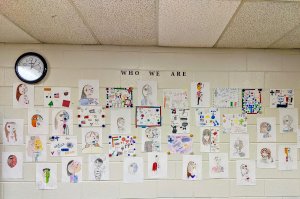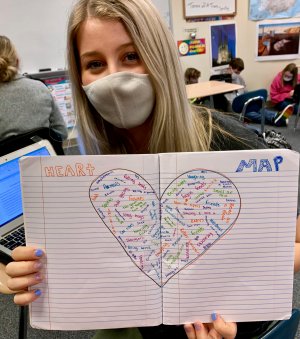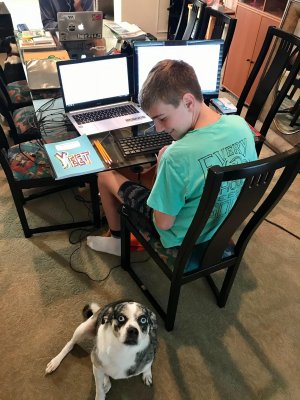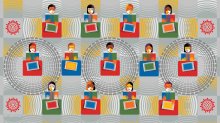6 Exercises to Get to Know Your Students Better—and Increase Their Engagement
Celebrating your middle and high school students’ unique identities can bolster connections and improve performance in school.
Your content has been saved!
Go to My Saved Content.While get-to-know-you activities are typically earmarked for the first weeks of school, they shouldn’t end there, say educators and researchers.
Whether it’s that they love to play baseball, have three brothers, or enjoy writing or photography, celebrating your students’ unique experiences and identities that keep them in school. Students who have a deeper sense of self——are also better able to define their goals and stay focused on pursuing them, concluded a 2014 study from David Yeager, Angela Duckworth, and colleagues.
We collected an array of class exercises from interviews with teachers, online resources, and our archives that will help students develop greater self-awareness and purpose. These insights can also give you a better sense of who they are, so you can be responsive to their interests—even if you’re separated by screens or masks.
Reflecting on Experiences: ‘Laws of Life’ Essays
In the early 2000s, educators in an urban, high-poverty district in New Jersey gave their middle and high school students an interesting essay assignment: Write about the values and principles that guide your life.
The seemingly small activity, called “Laws of Life,” is based on the work of philanthropist John Templeton, and it turned into a that helped students develop a stronger sense of self, purpose, and possibility for the future, according to Maurice Elias, a psychology professor at Rutgers University. The project has since been replicated all over the world.
To run the assignment in your class, Elias recommends asking students to reflect on their past—in and out of school—and the experiences and people that made them who they are. From there, have students discern key characteristics that have influenced their lives and then craft an essay—or create a video or other multimedia content—focused on the “laws” or principles that drive them.
Question prompts like “Who do you admire? List three of their admirable traits” and “Describe an incident or event from which you learned a lesson ‘the hard way’” can help guide students. Periodically throughout the year, have students refer back to their essays to reflect on what they wrote and ask themselves, “What’s changed?” and “What’s stayed the same?”
Exploring Identity—and Perceptions About It: Identity Charts
To get to know her students and ensure that they felt seen in her classroom, middle school teacher Shana White created a lesson to help them explore their identities. First, White set a foundation for discussion by defining identity and explaining how identities can sometimes be visible, like age, or invisible, like a person’s life experiences.
Then, with the permission of six of her friends, White shared photos of their faces and had students guess their “identity characteristics.” Afterward, she revealed the true details and led a class discussion about making assumptions about others based on how they look or act. To finish the project, students drew their own “identity portraits” or a picture of their face with half the face showing visible characteristics and the other half showing invisible characteristics.

The education organization Facing History and Ourselves recommends a similar exercise called the for middle school students. To start, select some key historical figures or fictional characters—think inclusively and avoid stereotypes, selecting a wide range of people from different backgrounds—and ask students to discuss “factors such as religion, gender, and geography” that influenced their identities.
Next, have students read the chapter “My Name” from the book The House on Mango Street, where the main character, Esperanza, talks about her name, revealing details about her culture. Ask students to create an identity chart for Esperanza, answering questions such as “What is her family like?” and “What does her name reveal about her personality?” Guided by the reading, students can then create identity charts for themselves and share them with the class.
Learning Important Details: Student Inventories
Student inventories can help teachers quickly discern details and facts about students that shape who they are, and can be used to plan further class activities and lessons. Ask students to list their favorite musicians, songs, sports, activities, games, or food, for example, or probe deeper with questions about their culture, memories, and family.
Another option is having students write 20 sentences that complete the prompt, “I am someone who…” or asking a short list of thought-provoking questions in one-to-one conferences. Target questions that tap into who students are now and who they hope to be, such as “What are some things that bug you about the world?” “What inspires you?” and “What dreams do you have after high school?”
Look for patterns in student responses, and use what you learn to make classroom lessons and activities connected to students’ interests, advises Rebecca Alber, an education professor in California, who says, “Students need to see connections between learning and their lived experiences.”
Understanding Interests: Passion Blogging
In Allison Berryhill’s high school English class, literary analysis exercises left her students “frozen,” and free-writing assignments produced hard-to-read rants. Influenced by the book , Berryhill started offering a new exercise called “passion blogging” last year, in which students write about topics that interest them.

Students start by drawing “heart maps,” or large hearts filled with illustrations and words that represent their passions. Then, they select one or two topics to explore further and look for related articles, images, and videos. Berryhill also gives accompanying class lessons on attribution of sources, texts, quotes, and imagery, and shares mentor texts to guide students’ writing.
Students’ blogs have run the gamut in subject matter, from pheasant hunting to hunger strikes to hiking, and give them an opportunity to dive deeply into things they care about. As part of the process, students are also tasked with reading and evaluating several of their classmates’ blogs. Overall, the low-stakes activity has served as a springboard to build students’ literary analysis skills for harder assignments, says Berryhill, while helping her get to know them better.
Documenting Your Life: Movies, Photos, and Podcasts
Though many teachers and students are feeling virtual brain drain, digital tools can provide new, creative outlets for students to share and define their interests and personalities. Teachers are having students create autobiographical about their lives and produce podcasts or write articles for digital school newspapers on issues they care about.
Influenced by her community’s experiences during the pandemic, Wendy McElfish, a high school teacher in California, taught a lesson on Dorothea Lange’s famous black-and-white photography from the Great Depression. Then, she had her students take their own photos with phones to document their lives. She guided them with the themes “life outside your door,” “through a window,” “different life inside,” and “porch photos of your family.”
"When kids are faced with terrible circumstances, sometimes it helps to take an artistic approach,” she said. “A lot of kids aren’t good writers, but they have an eye and they have a voice... [and] they can show the world what I see.”
Similarly, Lori Wenzinger, a middle school social studies teacher in South Carolina, paired up with a local photographer to create a three-week multimedia project called “Finding Your Joy.” After the photographer taught two classes on photo composition and mood, students were tasked with taking photos that “capture joyful moments throughout their day,” sharing and reviewing them as a class, and selecting their three favorites to keep in the class Google Drive.
Having Fun: Icebreakers, Games, and Accolades

In addition to more comprehensive assignments and lessons, teachers can build in short, entertaining activities that keep students engaged and reveal insights about who they are.
Trevor Boffone, a high school teacher in Texas, asked his students to submit their favorite song to a list at the start of the year. Now, at the beginning of each virtual class, he plays music to kick things off, incorporating students’ picks and his own.
Throughout remote learning, Cathleen Beachboard, a middle school teacher in Virginia, says she’s including fun activities like show-and-tells and theme days. This fall, she also adopted a practice that her superintendent uses for staff meetings called “Three Cool Things I’ve Seen.” Once a week, Beachboard calls out three things she’s observed about students from classes that week that recognize them for their individuality.
“I know a lot of teachers are struggling right now getting students pulled in. I found the more encouragement and authentic praise we give to students, the more they dive in,” she said. “These are scary times, but by giving students time to showcase their individuality, they will feel safe and ready to fully engage in learning.”
